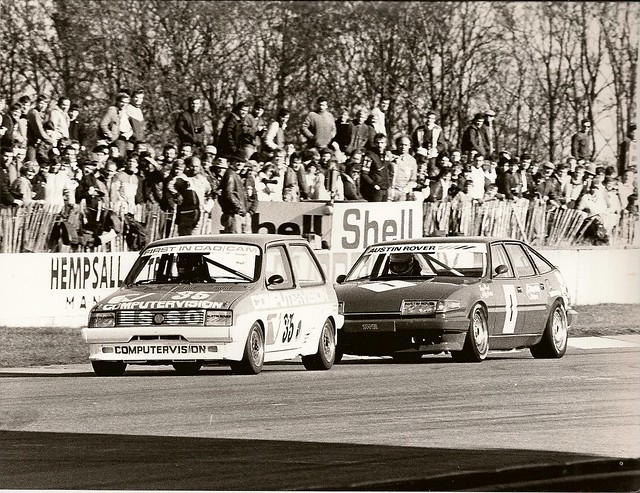To sorta add to this, what would have been had the FIA not withdrawn homologation for the World Touring Car Championship that ran in 1987? It started off slowly but didn't stay there long. The 1987 series included the Spa 24 Hours, RAC Tourist Trophy and Bathurst 1000, and I think it could easily expand further. So, how about it?
Firstly, it needs at least one round in the Americas. (Literally, the 1987 series had zero rounds in the Western Hemisphere.) The best bet I think for this would be starting the series in Latin America and then running rounds in the United States and Canada (Canada had no GP in 1988, so its an obvious pick) before bolting to Europe in early May. Running in Canada in late April may be a tad risky, but the Canadian GP for years ran in October so its possible. From there, Dijon and Monza are in May and Jarama in June, allowing the Nurburgring 24 Hours to run in late June in its traditional space. Brno goes to the WSC, so it goes out, leaving a gap. I'd fill this with a round in Scandinavia (Helsinki or Anderstorp are the best bets) in July and then Spa at the end of July, followed two weeks later by the two British rounds, with the first being a race at Donington Park and the second being the Tourist Trophy at Silverstone. Those done, its off to Japan for a round at either Suzuka or Fuji in mid-September, then to Bathurst and Phillip Island and finishing off in New Zealand at Wellington. This gives you a 1988 season of:
1) Autodromo Municipal Buenos Aires, Buenos Aires, Argentina (March 19)
2) Fair Park, Dallas, Texas, United States (April 10)
3) Mosport Park, Bowmanville, Ontario, Canada (April 24)
4) Circuit de Dijon-Prenois, Dijon, France (May 8)
5) Autodromo National di Monza, Monza, Italy (May 22)
6) Circuito del Jarama, Madrid, Spain (June 5)
7) Nurbrugring Nordschleife, Nurburg, Germany (June 25-26)
8) Helsinki Thunder, Helsinki, Finland (July 17)
9) Circuit de Spa-Francorchamps (July 30-31)
10) Donington Park, Leicestershire, United Kingdom (August 14)
11) Silverstone Circuit, Northamptonshire, United Kingdom (August 28)
12) Fuji Speedway, Oyama, Japan (September 11)
13) Mount Panorama Circuit, Bathurst, New South Wales, Australia (October 2)
14) Phillip Island Grand Prix Circuit, Phillip Island, Victoria, Australia (October 9)
15) Wellington City Circuit, Wellington, New Zealand (October 23)
Now, with the Americans now involved, you can expect some American cars involved - and indeed Group A isn't bad for them. The best cars of the era are the Ford Sierra Cosworth, BMW M3, Mercedes-Benz 190E 2.5-16, Jaguar XJS, Nissan Skyline R30 GTS, Toyota Supra Turbo, Holden Commodore VK SS and Alfa Romeo 75 Turbo. The 1987 WTCC (and the 1988 and later versions) would have the three-class system. The BMW, Alfa Romeo and Mercedes entries would qualify for Class 2, but all of the others above are class 3. Chrysler would probably best run with the Dodge Daytona Shelby, while GM and Ford would undoubtedly push the Sierras and Commodores, though I would expect Ford Mustang and Chevrolet Camaro / Pontiac Firebird entries. Class 1 would probably be dominated by the Toyota Corolla AE86 and Volkswagen Golf GTI.
1990 would see the arrival of Godzilla - the Nissan Skyline GT-R - and by now the Sierras and the big-inch cars would be easily outrunning the M3 and 190 Cosworth, though DTM-style engine work would probably be in the cards by this point and the 190 Evo II, complete with the massive rear wing, would be Mercedes' weapon of choice by then. The Alfa Romeo SZ would probably replace the 75 Turbo, though likely with the two-liter Twin Spark engine to be able to run in Class 2. The Daytona would probably be developed with the goal of serious horsepower as its chassis would be too poor for great handling.
This championship would be amazing for racing, particularly as the DTM evolutions of the M3 and 190 Cosworth got more serious and aimed to chase down the stupid-fast-in-a-straight-line Sierra Cosworth and the awesome Skyline GT-R. The Aussie giants would have rely on big-engine horsepower to keep up, and if Jaguar is still in it they'll have to run with the bigger V12 engines in their cars, facing the same issues the Australians would have. The Alfa SZ as a Group 2 car is a genuine threat too, as it is one of the finest handling cars of its generation. Japanese High Tech, Detroit (and Australian) cubic inches or European handling - who is your money on?

